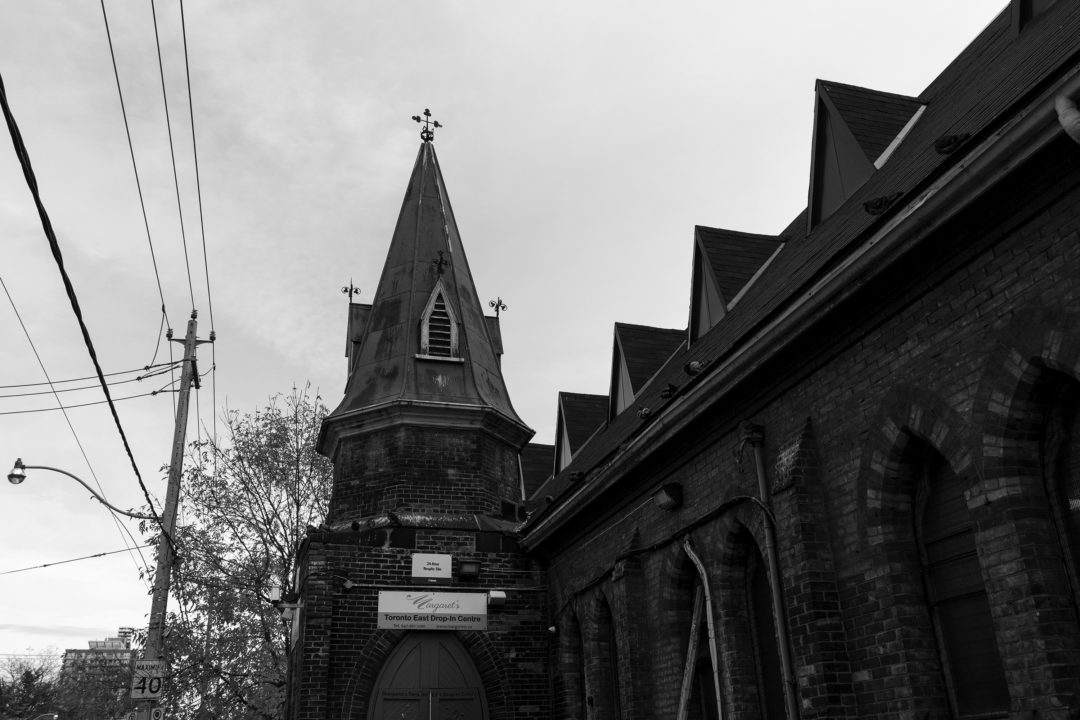In the past couple of years, I’ve developed the habit of walking unreasonable distances. It’s my boyfriend’s fault: he’s always favoured walking over any other modes of transportation, and when we started dating, walking became our main bonding activity. Sometimes, we’d end up in Leslieville for brunch, with heaping stacks of buttery pancakes swimming in maple syrup, freshly baked bread, and mimosas. Wintertime meant plenty of visits to the Distillery District, sipping hot chocolate as we meandered up and down the cobblestone streets. Nowadays, our ritual is to sit in a coffee shop — perhaps in rustic Corktown, or maybe somewhere slightly more upscale across the Don Valley — and sip coffee while we read, side by side, warm and cozy.
Our relationship was forged in the East End, where we continue to pass many idyllic weekend mornings together. But what we see while walking there seldom resembles the places where we end up. Instead, it can feel like stepping in and out of totally different universes.

Walking east on Dundas Street takes you first through Chinatown to the consumerism that is Yonge-Dundas Square, before spitting you out into a series of neighbourhoods that are decidedly less affluent. Multinational brands give way to local businesses with barred windows, and community aid centres become fixtures of the landscape — so do bright yellow needle disposal boxes bearing the symbol for ‘biohazard.’
Before you cross the bridge and emerge into the mecca of hipster culture that is Leslieville, you’ll pass through the affordable housing projects of Regent Park, coming within a block of where 15-year-old Mackai Bishop Jackson was shot dead in September.
Toronto is frequently called the most diverse city in the world, a title in which many residents take great pride. Oftentimes, our by-the-numbers diversity is taken to mean that Toronto is a bastion of tolerance and equal opportunities. We are, they say, a ‘cultural mosaic,’ where anybody can make their home and anybody can succeed.
In reality, Toronto’s cultural mosaic is increasingly divided along racial and economic seams. “Toronto is no longer a city of neighbourhoods,” writes David Hulchanski, a professor of housing and community development at U of T’s Factor-Inwentash Faculty of Social Work. “It’s a collection of islands segregated by income.”

The income inequality between Toronto’s neighbourhoods has increased 68 per cent since 1970, making us the most unequal city in Canada. We’ve also become much more polarized, meaning that middle-income neighbourhoods are disappearing. In 1980, Toronto had only five very low-income census tracts — in 2015, it had 88. And this inequality is colour-coded: visible minorities disproportionately occupy low-income areas.
Three decades ago, Toronto’s poorest areas were inner-city neighbourhoods. The impoverished areas that I frequently stumble into downtown are the last vestiges of this era; gentrification has transformed many of the surrounding neighbourhoods into hip, well-to-do places. But this doesn’t mean that poverty is going away; it’s just being relocated, mostly to Etobicoke, Scarborough, Brampton, and North York. We’re tucking it away someplace where we don’t have to look at it.
The reality of inequality in our city — and our refusal to confront it — was thrown into sharp relief over the summer. Even prior to the horrific Danforth shooting, Torontonians were thrown into a panic by a series of shootings in the downtown core that were believed to be gang-related, particularly one on Queen Street West that claimed the lives of two young men. Gun crime became a campaign issue in the lead up to the municipal elections; John Tory responded by increasing police presence to combat what is now widely understood as a major spike in gun violence.

But as the Toronto Star has pointed out, the increase in shootings from January to July this year have only amounted to about 10 per cent since 2016 — hardly proportional to the amount of news coverage that gun crime received over the summer. The reason for the panic wasn’t the number of shootings — it was their location. When Mackai Bishop Jackson, a child, was murdered, few of us heard anything about it. Why? Because it happened in Regent Park. Only when it happens in our bubble of wealth and privilege does violence become a problem. Even then, we didn’t take care not to re-elect Tory, whose strategy to ban handguns and expand policing will do nothing to target the discriminations and ensuing hopelessness that lie at the root of the violence.
This summer demonstrated how adverse privileged Torontonians are to confronting the structural inequality in our society. “[Torontonians] don’t talk too much about discrimination,” said Hulchanski in a conversation over the phone. “We think about these things and we say, ‘It’s worse in the United States.’” Prejudice doesn’t jive with our reputation as the cool, tolerant kid on the block. But that diversity doesn’t really mean much unless the same opportunities are available to everybody. And if trends continue, we won’t be any better off than those in the States for much longer.

